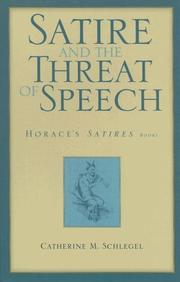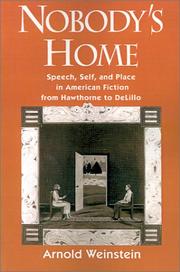| Listing 1 - 10 of 29 | << page >> |
Sort by
|

ISBN: 0299209504 9780299209506 9786612269837 1282269836 0299209539 9780299209537 9781282269835 6612269839 Year: 2005 Publisher: Madison University of Wisconsin Press
Abstract | Keywords | Export | Availability | Bookmark
 Loading...
Loading...Choose an application
- Reference Manager
- EndNote
- RefWorks (Direct export to RefWorks)
In his first book of 'Satires', written in the late, violent days of the Roman republic, Horace exposes satiric speech as a tool of power and domination. Using critical theories from classics, speech act theory, and others, Catherine Schlegel argues that Horace's acute poetic observation of hostile speech provides insights into the operations of verbal control that are relevant to his time and to ours. She demonstrates that though Horace is forced by his political circumstances to develop a new, unthreatening style of satire, his poems contain a challenge to our most profound habits of violence, hierarchy, and domination. Focusing on the relationships between speaker and audience and between old and new style, Schlegel examines the internal conflicts of a notoriously difficult text. This exciting contribution to the field of Horatian studies will be of interest to classicists as well as other scholars interested in the genre of satire.
Speech in literature. --- Verse satire, Latin --- History and criticism. --- Horace. --- Rome --- In literature. --- Speech in literature --- History and criticism
Book
ISBN: 9780813936970 9780813936963 0813936969 9780813936987 0813936985 0813936977 Year: 2015 Publisher: Charlottesville
Abstract | Keywords | Export | Availability | Bookmark
 Loading...
Loading...Choose an application
- Reference Manager
- EndNote
- RefWorks (Direct export to RefWorks)
Through her comparative methodology and historicist and feminist readings, Rosenthal asks readers to rethink the ways that speech and action intersect.
American fiction --- 19th century --- History and criticism --- Speech in literature --- Fern, Fanny --- Melville, Herman --- Stowe, Harriet Elizabeth Beecher --- Hawthorne, Nathaniel --- Speech in literature. --- History and criticism.
Book
ISBN: 9789004373488 9789004501584 9004373489 9004501584 Year: 2022 Publisher: Leiden, Netherlands ; Boston, Massachusetts : Brill,
Abstract | Keywords | Export | Availability | Bookmark
 Loading...
Loading...Choose an application
- Reference Manager
- EndNote
- RefWorks (Direct export to RefWorks)
"In ancient didactic poetry, poets frequently make use of imagery - similes, metaphors, acoustic images, models, exempla, fables, allegory, personifications, and other tropes - as a means to elucidate and convey their didactic message. In this volume, which arose from an international conference held at the University of Heidelberg in 2016, we investigate such phenomena and explore how they make the unseen visible, the unheard audible, and the unknown comprehensible. By exploring didactic poets from Hesiod to pseudo-Oppian and from Vergil and Lucretius to Grattius and Ovid, the authors in this collective volume show how imagery can clarify and illuminate, but also complicate and even undermine or obfuscate the overt didactic message. The presence of a real or implied addressee invites our engagement and ultimately our scrutiny of language and meaning"--
Didactic poetry, Classical --- Figures of speech in literature --- Didactic poetry, Classical. --- Figures of speech in literature. --- History and criticism --- Guitar --- Construction

ISBN: 9780521866408 0521866405 9780511988806 9780521187053 0521187052 9781107784383 1107784387 1107776783 110777926X 1107778670 1107784840 1107779944 1107781183 051198880X Year: 2007 Publisher: Cambridge Cambridge University Press
Abstract | Keywords | Export | Availability | Bookmark
 Loading...
Loading...Choose an application
- Reference Manager
- EndNote
- RefWorks (Direct export to RefWorks)
The Renaissance saw a renewed and energetic engagement with classical rhetoric; recent years have seen a similar revival of interest in Renaissance rhetoric. As Renaissance critics recognised, figurative language is the key area of intersection between rhetoric and literature. This book is the first modern account of Renaissance rhetoric to focus solely on the figures of speech. It reflects a belief that the figures exemplify the larger concerns of rhetoric, and connect, directly or by analogy, to broader cultural and philosophical concerns within early modern society. Thirteen authoritative contributors have selected a rhetorical figure with a special currency in Renaissance writing and have used it as a key to one of the period's characteristic modes of perception, forms of argument, states of feeling or styles of reading.
Literary rhetorics --- European literature --- Figures of speech in literature. --- History and criticism.

ISBN: 1280526629 0195344820 1429406992 9781429406994 9781280526626 9780195074932 0195074939 019508022X 9780195080223 0195074939 019508022X 9780195080223 9780195344820 019772549X 0190281960 Year: 2023 Publisher: New York ; Oxford University Press,
Abstract | Keywords | Export | Availability | Bookmark
 Loading...
Loading...Choose an application
- Reference Manager
- EndNote
- RefWorks (Direct export to RefWorks)
In this broad-based study of American fiction, canonical and otherwise, Arnold Weinstein examines closely the strong ties between language, history and culture, with a particular focus on freedom of the self.
American fiction --- Self in literature. --- Language and culture --- Freedom of speech in literature. --- Speech in literature. --- Home in literature. --- History and criticism. --- Freedom of speech in literature --- Home in literature --- Place (Philosophy) in literature --- Self in literature --- Speech in literature --- History and criticism --- Culture --- Place (Philosophy) in literature.
Book
ISBN: 1442624892 9781442624894 9781442637221 1442637226 1442624906 Year: 2016 Publisher: Toronto
Abstract | Keywords | Export | Availability | Bookmark
 Loading...
Loading...Choose an application
- Reference Manager
- EndNote
- RefWorks (Direct export to RefWorks)
Weaving Words and Binding Bodies presents the first comprehensive study of weaving and binding imagery through intertextual analysis and close readings of Beowulf, riddles, the poetry of Cynewulf, and other key texts.
English literature --- Figures of speech in literature. --- History and criticism. --- 450-1100 --- Old English Language, Period of
Book
ISBN: 900449880X 9789004498808 9789004498815 9004498818 Year: 2021 Publisher: Leiden, Netherlands ; Boston, Massachusetts : Brill,
Abstract | Keywords | Export | Availability | Bookmark
 Loading...
Loading...Choose an application
- Reference Manager
- EndNote
- RefWorks (Direct export to RefWorks)
Speech in Ancient Greek Literature is the fifth volume in the series Studies in Ancient Greek Narrative. There is hardly any Greek narrative text without speech, which need not surprise in the literature of a culture which loved theatre and also invented the art of rhetoric. This book offers a full discussion of the types of speech, the modes of speech and their effective alternation, and the functions of speech from Homer to Heliodorus, including the Gospels. For the first time speech-introductions and 'speech in speech' are discussed across all genres. All chapters also pay attention to moments when characters do not speak.
Book
ISBN: 9781503635999 Year: 2023 Publisher: Stanford, California : Stanford University Press,
Abstract | Keywords | Export | Availability | Bookmark
 Loading...
Loading...Choose an application
- Reference Manager
- EndNote
- RefWorks (Direct export to RefWorks)
"In this book, Amy R. Wong unravels the colonial and racial logic behind seemingly innocuous assumptions about "speech": that our words belong to us, and that self-possession is a virtue. Through readings of late-Victorian fictions of empire, Wong revisits the scene of speech's ideological foreclosures as articulated in postcolonial theory. Engaging Afro-Caribbean thinkers like Éduoard Glissant and Sylvia Wynter, Refiguring Speech reroutes attention away from speech and toward an anticolonial poetics of talk, which emphasizes communal ownership and embeddedness within the social world and material environment. Analyzing novels by Robert Louis Stevenson, Bram Stoker, George Meredith, Joseph Conrad, and Ford Madox Ford, Wong refashions the aesthetics of disordered speech--such as parroting, eavesdropping, profuse inarticulacy, and dysfluency--into alternate forms of communication that stand on their own as talk. Wong demonstrates how late nineteenth-century Britain's twin crises of territorialization--of empire and of new media--spurred narrative interests in capturing the sense that speech's tethering to particular persons was no longer tenable. In doing so, Wong connects this period to U.S. empire by constructing a genealogy of Anglo-American speech's colonialist and racialized terms of proprietorship. Refiguring Speech offers students and scholars of Victorian literature and postcolonial studies a powerful conceptualization of talk as an insurgent form of communication"--
English fiction --- Speech in literature. --- Postcolonialism. --- History and criticism. --- Victorian. --- anticolonial. --- colonialism. --- imperial fiction. --- poetics of relation. --- postcolonial. --- property. --- racialization. --- speech. --- talk.

ISBN: 1280424168 9786610424160 0803205287 9780803205284 9781280424168 0803239629 9780803239623 6610424160 0803239629 9780803239623 9780803220683 Year: 2005 Publisher: Lincoln, Neb. University of Nebraska Press
Abstract | Keywords | Export | Availability | Bookmark
 Loading...
Loading...Choose an application
- Reference Manager
- EndNote
- RefWorks (Direct export to RefWorks)
"Language has frequently been at the center of discussions about Holocaust writing. Yet English, a primary language of neither the persecutors nor the victims, has generally been viewed as marginal to the events of the Holocaust. Alan Rosen argues that this marginal status profoundly affects writing on the Holocaust in English and fundamentally shapes our understanding of the events. Sounds of Defiance chronicles the evolving status of English in writing about the Holocaust, from the Second World War to the 1990s." "Each chapter highlights a representative work from a different genre - psychology, sociology, memoir, tales, fiction, and film - and examines the special position of English with regard to the Holocaust, supported by references to the role of other languages, including Hebrew, Yiddish, and German."--Jacket.
American literature --- English language --- Holocaust, Jewish (1939-1945), in literature. --- Speech in literature. --- Holocaust, Jewish (1939-1945), in literature --- Speech in literature --- American Literature --- English --- Languages & Literatures --- Germanic languages --- Colloquial English --- Spoken English --- English literature --- History and criticism. --- Spoken English. --- Social aspects. --- Style. --- History and criticism --- Social aspects --- Style --- Metrics and rhythmics --- Rhetoric --- Pragmatics --- Sociolinguistics --- Thematology --- Sociology of literature
Book
ISBN: 0801464579 0801464102 9780801464577 9780801449659 0801449650 9780801464102 1322505330 Year: 2012 Publisher: Ithaca, NY
Abstract | Keywords | Export | Availability | Bookmark
 Loading...
Loading...Choose an application
- Reference Manager
- EndNote
- RefWorks (Direct export to RefWorks)
A central feature of English Renaissance humanism was its reverence for classical Latin as the one true form of eloquent expression. Yet sixteenth-century writers increasingly came to believe that England needed an equally distinguished vernacular language to serve its burgeoning national community. Thus, one of the main cultural projects of Renaissance rhetoricians was that of producing a "common" vernacular eloquence, mindful of its classical origins yet self-consciously English in character. The process of vernacularization began during Henry VIII's reign and continued, with fits and starts, late into the seventeenth century. However, as Jenny C. Mann shows in Outlaw Rhetoric, this project was beset with problems and conflicts from the start.Outlaw Rhetoric examines the substantial and largely unexplored archive of vernacular rhetorical guides produced in England between 1500 and 1700. Writers of these guides drew on classical training as they translated Greek and Latin figures of speech into an everyday English that could serve the ends of literary and national invention. In the process, however, they confronted aspects of rhetoric that run counter to its civilizing impulse. For instance, Mann finds repeated references to Robin Hood, indicating an ongoing concern that vernacular rhetoric is "outlaw" to the classical tradition because it is common, popular, and ephemeral. As this book shows, however, such allusions hint at a growing acceptance of the nonclassical along with a new esteem for literary production that can be identified as native to England. Working across a range of genres, Mann demonstrates the effects of this tension between classical rhetoric and English outlawry in works by Spenser, Shakespeare, Sidney, Jonson, and Cavendish. In so doing she reveals the political stakes of the vernacular rhetorical project in the age of Shakespeare.
English language --- Rhetoric, Renaissance --- National characteristics, English, in literature. --- Figures of speech in literature. --- Eloquence in literature. --- English literature --- Renaissance rhetoric --- Germanic languages --- Rhetoric --- Handbooks, manuals, etc. --- Early works to 1800. --- History and criticism.
| Listing 1 - 10 of 29 | << page >> |
Sort by
|

 Search
Search Feedback
Feedback About UniCat
About UniCat  Help
Help News
News